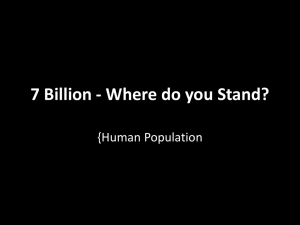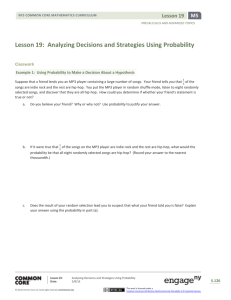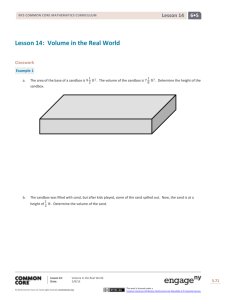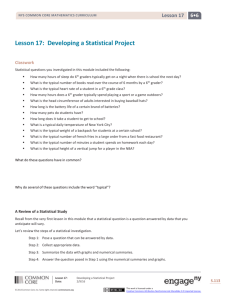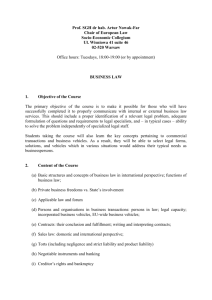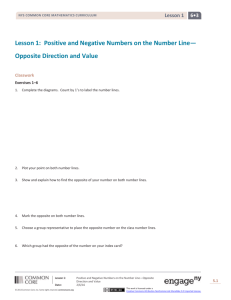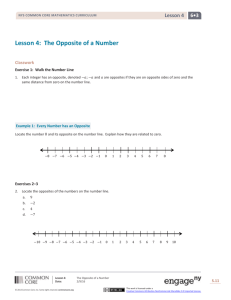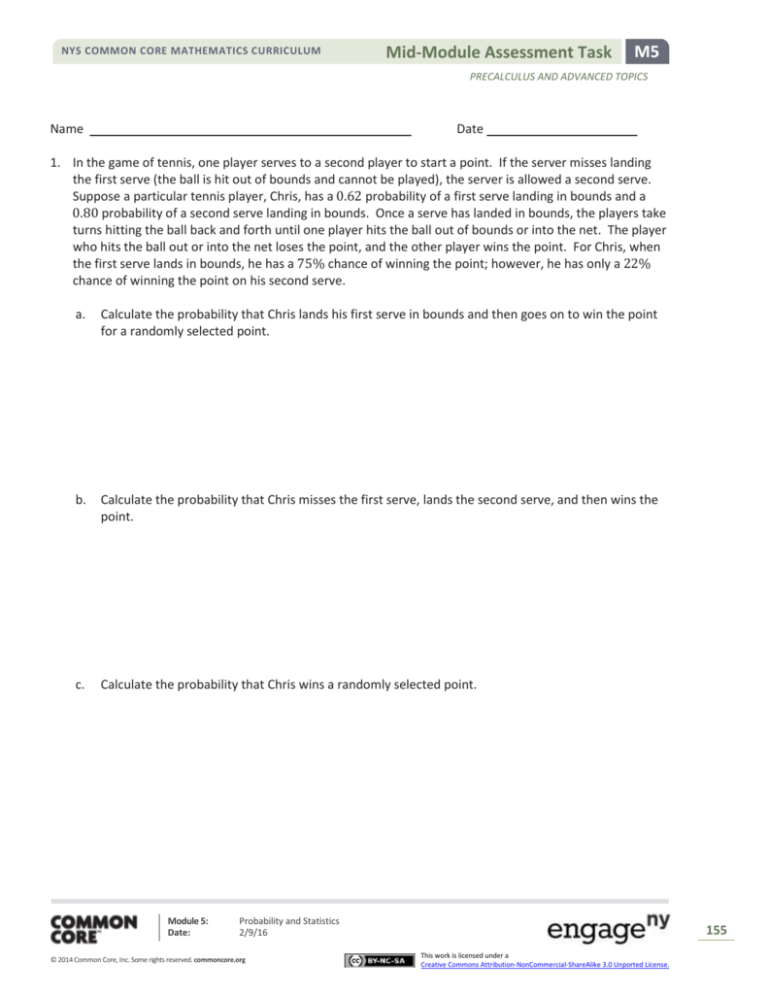
NYS COMMON CORE MATHEMATICS CURRICULUM
Mid-Module Assessment Task
M5
PRECALCULUS AND ADVANCED TOPICS
Name
Date
1. In the game of tennis, one player serves to a second player to start a point. If the server misses landing
the first serve (the ball is hit out of bounds and cannot be played), the server is allowed a second serve.
Suppose a particular tennis player, Chris, has a 0.62 probability of a first serve landing in bounds and a
0.80 probability of a second serve landing in bounds. Once a serve has landed in bounds, the players take
turns hitting the ball back and forth until one player hits the ball out of bounds or into the net. The player
who hits the ball out or into the net loses the point, and the other player wins the point. For Chris, when
the first serve lands in bounds, he has a 75% chance of winning the point; however, he has only a 22%
chance of winning the point on his second serve.
a.
Calculate the probability that Chris lands his first serve in bounds and then goes on to win the point
for a randomly selected point.
b.
Calculate the probability that Chris misses the first serve, lands the second serve, and then wins the
point.
c.
Calculate the probability that Chris wins a randomly selected point.
Module 5:
Date:
Probability and Statistics
2/9/16
© 2014 Common Core, Inc. Some rights reserved. commoncore.org
155
This work is licensed under a
Creative Commons Attribution-NonCommercial-ShareAlike 3.0 Unported License.
NYS COMMON CORE MATHEMATICS CURRICULUM
Mid-Module Assessment Task
M5
PRECALCULUS AND ADVANCED TOPICS
2. In Australia, there are approximately 100 species of venomous snakes, but only about 12 have a deadly
bite. Suppose a zoo randomly selects one snake from each of five different species to show visitors.
What is the probability that exactly one of the five snakes shown is deadly?
3. In California (CA), standard license plates are currently of the form: 1 number–3 letters–3 numbers.
Assume the numbers are 0– 9 and the letters are A–Z.
a.
In theory, how many different possible standard CA license plates are there, assuming we can repeat
letters and numbers?
b.
How many different possible standard CA license plates are there if we are not allowed to repeat any
letters or numbers?
c.
For part (b), did you use permutations or combinations to carry out the calculation? Explain how
you know.
Module 5:
Date:
Probability and Statistics
2/9/16
© 2014 Common Core, Inc. Some rights reserved. commoncore.org
156
This work is licensed under a
Creative Commons Attribution-NonCommercial-ShareAlike 3.0 Unported License.
Mid-Module Assessment Task
NYS COMMON CORE MATHEMATICS CURRICULUM
M5
PRECALCULUS AND ADVANCED TOPICS
4. When there is a problem with a computer program, many people call a technical support center for help.
Several people may call at once, so the center needs to be able to have several telephone lines available
at the same time. Suppose we want to consider a random variable that is the number of telephone lines
in use by the technical support center of a software manufacturer at a particular time of day. Suppose
that the probability distribution of this random variable is given by the following table:
𝑥
0
1
2
3
4
5
𝑝(𝑥)
0.35
0.20
0.15
0.15
0.10
0.05
a.
Produce a graph of the probability distribution for this random variable, including all relevant labels.
b.
Calculate the expected value of the random variable.
c.
Explain how to interpret this expected value in context.
Module 5:
Date:
Probability and Statistics
2/9/16
© 2014 Common Core, Inc. Some rights reserved. commoncore.org
157
This work is licensed under a
Creative Commons Attribution-NonCommercial-ShareAlike 3.0 Unported License.
Mid-Module Assessment Task
NYS COMMON CORE MATHEMATICS CURRICULUM
M5
PRECALCULUS AND ADVANCED TOPICS
5. The following table lists the number of U.S. households (in thousands) with 0 vehicles, 1 vehicle, 2
vehicles, or 3 or more vehicles for all households responding to the 2009 National Household Travel
Survey.
a.
No vehicle
One vehicle
Two vehicles
Three or more vehicles
9,828
36,509
41,077
25,668
Use these data to create a table of relative frequencies that could be used as estimates of the
probability distribution of number of vehicles for a randomly selected U.S. household (that
responded to the survey).
No vehicle
One vehicle
Two vehicles
Three or more vehicles
b.
Suppose you want to examine the distribution of the number of vehicles in all U.S. households.
Define a random variable that corresponds to the probability distribution in part (a).
c.
Assume for the moment that the last column corresponds to exactly three vehicles. Calculate the
expected number of vehicles per household.
Module 5:
Date:
Probability and Statistics
2/9/16
© 2014 Common Core, Inc. Some rights reserved. commoncore.org
158
This work is licensed under a
Creative Commons Attribution-NonCommercial-ShareAlike 3.0 Unported License.
NYS COMMON CORE MATHEMATICS CURRICULUM
Mid-Module Assessment Task
M5
PRECALCULUS AND ADVANCED TOPICS
d.
Now reconsider the last category. Suppose we were to find the information for the actual number of
vehicles for these households. Would the expected number of vehicles per household with this new
information be larger or smaller than the expected value you found in (c)? Explain your reasoning.
e.
Suppose a town has about 4,500 households. What is a good estimate for the number of cars in
town? Explain how you determined your answer.
Module 5:
Date:
Probability and Statistics
2/9/16
© 2014 Common Core, Inc. Some rights reserved. commoncore.org
159
This work is licensed under a
Creative Commons Attribution-NonCommercial-ShareAlike 3.0 Unported License.
NYS COMMON CORE MATHEMATICS CURRICULUM
Mid-Module Assessment Task
M5
PRECALCULUS AND ADVANCED TOPICS
A Progression Toward Mastery
Assessment
Task Item
1
a
STEP 1
Missing or
incorrect answer
and little evidence
of reasoning or
application of
mathematics to
solve the problem.
STEP 2
Missing or
incorrect answer
but evidence of
some reasoning or
application of
mathematics to
solve the problem.
STEP 3
A correct answer
with some
evidence of
reasoning or
application of
mathematics to
solve the problem,
or an incorrect
answer with
substantial
evidence of solid
reasoning or
application of
mathematics to
solve the problem.
STEP 4
A correct answer
supported by
substantial
evidence of solid
reasoning or
application of
mathematics to
solve the problem.
Student is not able to
calculate a probability.
Student does not set up
as a multiplication rule
calculation.
Student recognizes the
calculation method but
substitutes the numbers
incorrectly or does not
explain solution
approach sufficiently.
Student recognizes the
conditional probabilities
and uses the
multiplication rule to
combine.
Student is not able to
calculate a probability.
Student constructs a
probability tree or table
but is not able to finish
it or does not have the
correct outcomes.
Student recognizes the
calculation method but
does not utilize
probability of first serve
not landing in or does
not explain the solution
approach sufficiently.
Student recognizes the
conditional probabilities
and uses the
multiplication rule to
combine.
Student is not able to
calculate a probability
or assumes 0.50.
Student does not
weight probabilities of
winning points by
probabilities of serves
landing in.
Student does not realize
(a) and (b) are mutually
exclusive events.
AND/OR
Student attempts a
new, incorrect
approach.
Student sums answers
from (a) and (b).
Student is not able to
calculate a probability.
Student uses incorrect
probability rules, such
1
as .
Student fails to consider
the 88 nonvenomous
species.
Student uses
combinations to set up
the problem.
S-CP.B.8
b
S-CP.B.8
c
S-CP.B.8
2
S-CP.B.9
5
Module 5:
Date:
Probability and Statistics
2/9/16
© 2014 Common Core, Inc. Some rights reserved. commoncore.org
160
This work is licensed under a
Creative Commons Attribution-NonCommercial-ShareAlike 3.0 Unported License.
NYS COMMON CORE MATHEMATICS CURRICULUM
Mid-Module Assessment Task
M5
PRECALCULUS AND ADVANCED TOPICS
3
a
Student is not able to
approach problem.
Student calculates a
probability.
Student employs
multiplication rule but
does not allow for
repeats or does not
take into account
number in each
category.
Student employs
multiplication rule.
Student is not able to
approach problem.
Student calculates a
probability.
Student employs
multiplication rule but
allows for repeats.
Student employs
multiplication rule and
does not allow repeats
(could begin second set
at 10 again; could fail to
include zero in first set).
Student does not
address the question
(e.g., “yes”).
Student specifies an
answer consistent with
the approach but is not
able to explain why in
terms of order of
outcomes.
Student specifies
permutations but is not
able to explain why.
AND/OR
Student incorrectly
identifies a permutation
approach as using
combinations.
Student specifics
permutations and
relates to the
distinctness of the
outcomes based on
order.
Student does not
produce a graph.
Student produces a
graph of 𝑥 values that
does not consider 𝑝(𝑥)
values.
Student produces a
graph but does not
label both axes.
Student produces a
graph of 𝑝(𝑥) vs. 𝑥 with
appropriate labels on
both axes.
Student does not use
provided information.
Student calculates an
average of the 𝑥 values
and does not use 𝑝(𝑥)
information.
Student does not show
work or has a
substantial calculation
error.
Student calculates
expected value
correctly and shows
work.
Student provides an
incorrect statement
about expected value
(e.g., most probable
value).
Student merely restates
a definition/calculation
of expected value
without clarifying the
interpretation.
Student indicates an
average but does not
sufficiently put
statements in context
(e.g., no “long-run”).
Student interprets
expected value as a
long-run average in
context.
Student provides values
that do not sum to one.
Student does not use
the counts provided to
create the relative
frequencies (e.g.,
assumes 0.25 for each).
Student creates a table
of relative frequencies,
but calculation details
are unclear.
Student creates a table
of relative frequencies,
and calculation details
are clear.
Student creates a
variable but is not
considering probability
distributions.
Student does not
convey the mapping of
outcomes to numbers,
giving more of a
definition of random
outcomes.
Student discusses the 0,
1, 2, 3 outcomes but
does not define a
random variable.
Student creates a
mapping of outcomes
to numerical values.
S-CP.B.9
b
S-CP.B.9
c
S-CP.B.9
4
a
S-MD.A.1
b
S-MD.A.2
c
S-MD.A.2
5
a
S-MD.A.4
b
S-MD.A.1
Module 5:
Date:
Probability and Statistics
2/9/16
© 2014 Common Core, Inc. Some rights reserved. commoncore.org
161
This work is licensed under a
Creative Commons Attribution-NonCommercial-ShareAlike 3.0 Unported License.
NYS COMMON CORE MATHEMATICS CURRICULUM
Mid-Module Assessment Task
M5
PRECALCULUS AND ADVANCED TOPICS
c
S-MD.A.4
d
S-MD.A.3
e
S-MD.A.4
Student does not
calculate an expected
value.
Student calculates an
expected value but not
using 3 in the last
category (e.g., ignores
category or uses a
number larger than 3).
Student makes a
calculation error or
does not show
sufficient calculation
details.
Student correctly
calculates an expected
value using 3 as the last
outcome and shows
sufficient calculation
details.
Student does not relate
comments to
calculation details of
expected value.
Student claims the
expected value will be
smaller because the
probabilities of
different outcomes will
be smaller.
Student indicates the
expected value will be
larger but does not
have a clear
explanation.
Student explains
reasoning that larger
numbers increase the
weighted average.
Student provides a
response that is not in
“number of cars.”
Student does not utilize
the information of
expected value or the
given probability
distribution (e.g.,
assumes two cars per
household).
Student does not
explain solution
approach but finds
correct answer.
Student multiplies the
expected value by the
number of households,
and calculation details
are clear.
Module 5:
Date:
Probability and Statistics
2/9/16
© 2014 Common Core, Inc. Some rights reserved. commoncore.org
162
This work is licensed under a
Creative Commons Attribution-NonCommercial-ShareAlike 3.0 Unported License.
NYS COMMON CORE MATHEMATICS CURRICULUM
Mid-Module Assessment Task
M5
PRECALCULUS AND ADVANCED TOPICS
Name
Date
1. In the game of tennis, one player serves to a second player to start a point. If the server misses landing
the first serve (the ball is hit out of bounds and cannot be played), the server is allowed a second serve.
Suppose a particular tennis player, Chris, has a 0.62 probability of a first serve landing in bounds and a
0.80 probability of a second serve landing in bounds. Once a serve has landed in bounds, the players take
turns hitting the ball back and forth until one player hits the ball out of bounds or into the net. The player
who hits the ball out or into the net loses the point, and the other player wins the point. For Chris, when
the first serve lands in bounds, he has a 75% chance of winning the point; however, he has only a 22%
chance of winning the point on his second serve.
a.
Calculate the probability that Chris lands his first serve in bounds and then goes on to win the point
for a randomly selected point.
P(first serve in )P (wins point│first serve in)= 0.62 (0.75 )=0.465
b.
Calculate the probability that Chris misses the first serve, lands the second serve, and then wins the
point.
P(first serve out and second serve in)P(wins point|second serve in)= 0.38(0.80)(0.22)
=0.06688.
c.
Calculate the probability that Chris wins a randomly selected point.
P(first serve in)P(wins point|first serve in)+P(second serve)P(wins point|second serve)
= 0.465+0.06688= 0.53188.
Module 5:
Date:
Probability and Statistics
2/9/16
© 2014 Common Core, Inc. Some rights reserved. commoncore.org
163
This work is licensed under a
Creative Commons Attribution-NonCommercial-ShareAlike 3.0 Unported License.
NYS COMMON CORE MATHEMATICS CURRICULUM
Mid-Module Assessment Task
M5
PRECALCULUS AND ADVANCED TOPICS
2. In Australia, there are approximately 100 species of venomous snakes, but only about 12 have a deadly
bite. Suppose a zoo randomly selects one snake from each of five different species to show visitors.
What is the probability that exactly one of the five snakes shown is deadly?
C(12, 1)C(88,4)
C(100,5)
≈0.372.
3. In California (CA), standard license plates are currently of the form: 1 number–3 letters–3 numbers.
Assume the numbers are 0–9 and the letters are A–Z.
a.
In theory, how many different possible standard CA license plates are there, assuming we can repeat
letters and numbers?
10 × 263 × 103 = 175,760,000
b.
How many different possible standard CA license plates are there if we are not allowed to repeat any
letters or numbers?
10 × 26 × 25 × 24 × 9 × 8 × 7 = 78,624,000 (may start second sequence of
numbers at 10 again)
c.
For part (b), did you use permutations or combinations to carry out the calculation? Explain how
you know.
I used permutation because order matters.
Module 5:
Date:
Probability and Statistics
2/9/16
© 2014 Common Core, Inc. Some rights reserved. commoncore.org
164
This work is licensed under a
Creative Commons Attribution-NonCommercial-ShareAlike 3.0 Unported License.
Mid-Module Assessment Task
NYS COMMON CORE MATHEMATICS CURRICULUM
M5
PRECALCULUS AND ADVANCED TOPICS
4. When there is a problem with a computer program, many people call a technical support center for help.
Several people may call at once, so the center needs to be able to have several telephone lines available
at the same time. Suppose we want to consider a random variable that is the number of telephone lines
in use by the technical support center of a software manufacturer at a particular time of day. Suppose
that the probability distribution of this random variable is given by the following table:
𝑥
0
1
2
3
4
5
𝑝(𝑥)
0.35
0.20
0.15
0.15
0.10
0.05
a.
Produce a graph of the probability distribution for this random variable, including all relevant labels.
b.
Calculate the expected value of the random variable.
Expected value = 0(0.35) + 1(0.20) + 2(0.15) + 3(0.15) + 4(0.10) + 5(0.05) = 1.6
telephone lines.
c.
Explain how to interpret this expected value in context.
If we were to observe the number of phone lines in use over a very large number of
days, the average number of lines in use will approach 1.6 in the long run.
Module 5:
Date:
Probability and Statistics
2/9/16
© 2014 Common Core, Inc. Some rights reserved. commoncore.org
165
This work is licensed under a
Creative Commons Attribution-NonCommercial-ShareAlike 3.0 Unported License.
Mid-Module Assessment Task
NYS COMMON CORE MATHEMATICS CURRICULUM
M5
PRECALCULUS AND ADVANCED TOPICS
5. The following table lists the number of U.S. households (in thousands) with 0 vehicles, 1 vehicle, 2
vehicles, or 3 or more vehicles for all households responding to the 2009 National Household Travel
Survey.
a.
b.
No vehicle
One vehicle
Two vehicles
Three or more vehicles
9,828
36,509
41,077
25,668
Use these data to create a table of relative frequencies that could be used as estimates of the
probability distribution of number of vehicles for a randomly selected U.S. household (that
responded to the survey).
No vehicle
One vehicle
Two vehicles
Three or more
vehicles
0.0869
0.323
0.363
0.227
Total
113,082
(thousand)
Suppose you want to examine the distribution of the number of vehicles in all U.S. households.
Explain how you could represent this as a random variable.
We could let x represent the number of vehicles, so x = 0, 1, 2, 3, ….
c.
Assume for the moment that the last column corresponds to exactly three vehicles. Calculate the
expected number of vehicles per household.
0(0.0869) + (1)(0.323) + 2(0.363) + 3(0.227) = 1.73 vehicles.
Module 5:
Date:
Probability and Statistics
2/9/16
© 2014 Common Core, Inc. Some rights reserved. commoncore.org
166
This work is licensed under a
Creative Commons Attribution-NonCommercial-ShareAlike 3.0 Unported License.
NYS COMMON CORE MATHEMATICS CURRICULUM
Mid-Module Assessment Task
M5
PRECALCULUS AND ADVANCED TOPICS
d.
Now reconsider the last category. Suppose we were to find the information for the actual number of
vehicles for these households. Would the expected number of vehicles per household with this new
information be larger or smaller than the expected value you found in (c)? Explain your reasoning.
This would give us a larger expected value because we would decrease the probability of
multiplying 3 vehicles and then add in larger numbers of vehicles.
e.
Suppose a town has about 4,500 households. What is a good estimate for the number of cars in
town? Explain how you determined your answer.
We expect 1.73 vehicles per household, so 4,500 households would correspond to 1.73
× 4,500 = 7,785 vehicles.
Module 5:
Date:
Probability and Statistics
2/9/16
© 2014 Common Core, Inc. Some rights reserved. commoncore.org
167
This work is licensed under a
Creative Commons Attribution-NonCommercial-ShareAlike 3.0 Unported License.


